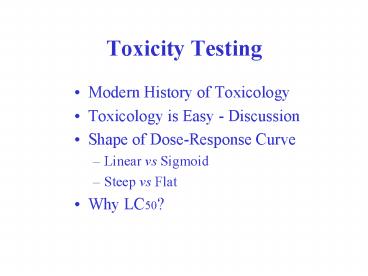Toxicity Testing - PowerPoint PPT Presentation
1 / 18
Title:
Toxicity Testing
Description:
1947 - FIFRA, 1st non-food or drug toxics law. 1955 - Delaney Amendment ... Oral dose/gavage. Diet. Intraperitoneal injection. Inhalant. Dermal. Dry vial ... – PowerPoint PPT presentation
Number of Views:115
Avg rating:3.0/5.0
Title: Toxicity Testing
1
Toxicity Testing
- Modern History of Toxicology
- Toxicology is Easy - Discussion
- Shape of Dose-Response Curve
- Linear vs Sigmoid
- Steep vs Flat
- Why LC50?
2
Cycle of Response to Toxics
Public response/ outcry
Toxic effect of one substance documented
Legislation to regulate toxic effects
More studies of other chemicals Improved
analytical accuracy
3
Modern History of Toxicology
- Industrial Revolution
- The Jungle, Wiley Bill
- 1900 - vital amines, rat bioassays
- 1919 - Alice Hamilton, Occup. Health
- 1920s- Prohibition, Bootleg, Ginger Jake
- 1930-40 - WWII Chemistry, NIH Founded
4
Modern History of Toxicology
- 1938 - Sulfaniliamide Disaster, US FDA
- 1947 - FIFRA, 1st non-food or drug toxics law
- 1955 - Delaney Amendment
- 1962 - Silent Spring by Rachel Carson
- 1980s - Vastly improved analytical sensitivity
- 1996 - Delaney Replaced by FQPA
- (Food Quality Protection Act)
5
Discussion - Toxicology is Easy
Toxicology is the science of poisons and deals
with how substances make organisms ill or kills
them. Thus, preventing toxic effects simply
involves identifying the concentration of a
substance that causes those effects and
preventing exposures at or above that
concentration.
What challenges or complexities may cloud the
simplicity of this commonly held perception?
6
Shape of the Dose-Response Relationship
7
Why LC50?
100
Response
0
Low
High
Concentration (or Dose)
8
Acute Toxicity Test Design
- Test Material (toxicant)
- Pure
- Commercial formulation
- Mixtures of known concentration
- Carriers/solvents
- Unknown mixtures (eg. sediment,effluent)
9
- 2. Test Organism
- Most sensitive
- Most representative
- Wild species
- Rear in lab
- Known physiology
- Bred for uniformity
- Certified disease free
- Known susceptible strain
Ex Daphnia Fathead minnows Rats/Mice Animal
Cell cultures Algal cell cultures Duckweed Meal
worms Earthworms Frogs/tadpoles
10
- 3. Exposure Method/Apparatus
- Oral dose/gavage
- Diet
- Intraperitoneal injection
- Inhalant
- Dermal
- Dry vial
- Static vs Flow-thru aquaria
11
- 4. Experimental Design
- Sample size
- Unbiased allocation of subjects
- Test environment (temp, 02, pH, light cycle,
food, etc) - Negative controls (untreated, solvent/carrier)
- Positive controls (toxin with well known effect)
- Baseline measurements (size, test envt, etc)
12
- 5. Range-Finding Test
- 10X progression of toxin concentration
- 3-5 individuals per concentration
- 5 concentrations plus control(s)
13
- 6. Definitive Test
- Expand on meaningful conc. From range test
- 5 conc. Plus control(s)
- Geometric progression of conc. (2X or higher)
- 1 conc. Kills lt 35 1 conc. Kills gt 65
- 10 individuals per concentration
- Replicates?
- 96h, no food
14
- 7. Endpoint (what response to measure?)
- Death (LC50, LD50)
- Paralysis, loss of equilibrium (EC50)
- Other sub-lethal endpoints (EC50)
Pop. growth rate Indiv. growth rate Foraging
behavior Escape behavior Learning/cognitive
Bone formation Protein production Enzyme
activity Chromosome breakage RNA synthesis
15
8. Calculations
- Plot mortality vs log conc. (or dose)
- Do not include control data in curve fit
- If control mortality exceeds 10, correct w/
Abbotts formula - Do probit analysis for accurate LC50
- Calc. 95 confidence intervals
16
(Lindane)
Diff. toxicity to diff. spp. Diff. Toxicity via
diff routes of exposure why?
17
Yikes! those are my tax dollars!
What about transgenerational effects??
18
Scale of Toxicological Endpoints
Increasing reality Increasing cost Increasing
uncertainty































